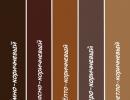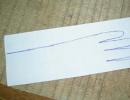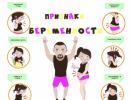Lesson summary on Easter eggs. Easter egg made of paper for elementary school children. Master class with photos. Consolidating new material
Lesson 28. DECORATION OF PRODUCTS. TYPES OF DECORATING EASTER EGGS
Target: Continue to familiarize students with folk art, with decoration of products; introduce the different types of Easter egg decoration; develop skills in appliqué techniques; to form aesthetic feelings, taste; cultivate emotional and aesthetic perception of works folk craftsmen, careful handling of materials, accuracy during work, stimulate the creative potential of students.
Equipment: wooden (or empty chicken) eggs; colored threads; beads; colored stripes; glue; scissors; long needle with a large eye; product samples and drawings; multimedia board.
Lesson progress
I. ORGANIZATIONAL MOMENT
1. Congratulations
2. Checking readiness for the lesson
3. Organizing workspaces
II. PERCEPTION AND AWARENESS OF NEW MATERIAL
1. Communicating the topic and purpose of the lesson
Today in the lesson we will continue our acquaintance with folk art and decorating products, namely, with the varieties of decorating Easter eggs.
2. Teacher's story
Multimedia presentation
Let's remember what types of Easter egg decorations do you know?
Easter eggs- an egg painted in one color.
Rappy girls- the egg is painted in dark brown color, and the design is applied with a needle or awl.
Krapanki- the egg is decorated with multi-colored dots using wax and paints.
Malevanki- the egg is painted using a brush and paints.
Raw chicken eggs are used to make Easter eggs. First, you need to wash them well in water, dissolving a little baking soda in it.
The eggs are then immersed in a weak vinegar solution. When they dry, they begin to paint. Most often this is done using wax. Natural beeswax is placed in a small ceramic vessel or crock. The vessel with wax is placed on a small fire in the oven or on a diffuser on a gas stove. The wax should be hot, but not boiling.
They paint the eggs with a pisachka - a small wooden stick in which a hole is burned with a hot nail in order to insert a metal tip or a tube rolled out of foil. This tip is then secured with thread. The pissant is held motionless, only the egg is rotated. After painting, the egg is immersed in paint and then dried.
Physical education minute
3. Sample demonstration and analysis
1) Teacher briefing.
Work from the textbook (p. 96). Multimedia presentation
Easter eggs can be decorated not only in the traditional way (dyes, wax), but also with a variety of materials: beads, colored paper, woolen threads.
Remember children's tongue twisters that mention numbers? What about fairy tales in which there are certainly either three kingdoms or three sisters? For our ancestors, numbers were sacred, each had its own meaning and its own power. Therefore, the division of the surface of the egg into a certain number of parts and the constant repetition of certain elements is not accidental.
The halving conveyed the idea of two worlds. Most often they were divided into three parts vertically, this is how the three celestial spheres were designated.
When divided into four parts, a cross is formed, which means the four cardinal directions.
The classic division of the hemispheres into four parts, each of which is divided into three, conveys the idea of four seasons with three months. According to other ideas, the world was divided into six sides. This spatial orientation is conveyed by a six-pointed star.
While studying Easter eggs, scientists suggested that in ancient times there was an eight-year calendar cycle. In folk mythology, the sky has eight spheres - “clouds”: seven are blue, and the eighth is red, on which God himself sits.
Very interesting is the division into forty parts, the so-called forty-klintsy. Each wedge designated a certain type of human activity or natural phenomenon, and in the Christian vision - forty days of fasting.
Let's remember what colors we will use? What is the meaning of these colors?
Red is joy.
Blue is the color of water, a wish for a good harvest.
Green - life, wishes for health.
Brown is the color of the earth and bestows wisdom.
Use the crossword to guess what materials and tools we will use.
Crossword
1. Long and fluffy, follows her metal sister with her tail. (Thread)
2. You follow her, she follows you, you follow her, she follows you. (Needle)
3. Two rings, two ends, and a nail in the middle. (Scissors)
4. Nosy Ivan
Wooden clothes.
He walks in an open field
And he runs his nose over it,
Not cut, not combed -
Chop with a sharp knife. (Pencil)
5. Everything he touches cannot be torn off. (Glue)
6. Cut the ice and get the fruit:
Silver on top, gold inside. (Egg)
7. Put a small round one on a needle and make beads. (Beads)
So, let's get to work!
1. Take an egg and with a simple pencil draw lines - boundaries between colors.
2. Coat part of the egg with glue and wrap it tightly with thread.
3. Work the other parts of the pattern one by one in the same way.
4. Thread a thread or strip through the holes in the egg using a needle with a large eye.
5. The surface of the egg, covered with threads, can be decorated with beads and made into an ornament.
2) Repetition of safety rules during work.
4. Interesting to know!
WAYS OF COLORING AND DECORATING EASTER EGGS
First of all, you need to learn certain subtleties. To keep the shell intact, it is advisable to keep the eggs for about an hour. room temperature, and add a tablespoon of salt to the water during cooking. In order for the paint to apply more evenly, before painting the eggs must be degreased - wiped with soapy water or alcohol.
Most affordable way coloring eggs - boil them in a previously prepared decoction of onion peels. The color - from light yellow to red-brown - depends on the concentration of the decoction. You can also prepare a decoction of birch leaves (young or dry) or young walnut leaves, strain and cook eggs in it over low heat for 10-12 minutes from the moment of boiling. Eggs will be purchased yellow. Eggs are colored with natural dyes in two ways. Cold method: already boiled eggs need to be kept in juice (beetroot, carrot). Hot method: Boil eggs in a saucepan with water, a teaspoon of vinegar and natural dyes for 15 minutes to obtain different colors.
Light red color comes from beets or blueberries; orange - onion; light yellow - lemons, oranges or carrots; yellow - turmeric roots, walnut shells; light green - spinach and nettle leaves; green - green apples; blue or purple - red cabbage leaves; beige or brown - coffee.
If, after coloring, you put the eggs in the same broth in the refrigerator overnight, the color will be brighter.
To get a speckled pattern, wet eggs are rolled in dry rice, wrapped in gauze (the ends of the gauze must be tightly tied with thread so that the rice sticks to the egg) and boiled in onion skins in the usual way. To achieve a marbled effect, you need to wrap the eggs in onion skins and tie a cotton cloth on top, the folds of which will be reflected on the surface of the shell.
If you wrap eggs with thick threads when dyeing, you will get stripes on them - along or across, depending on how you wrap the shell. Flowers or leaves different shapes will affect the eggs if, for example, leaves of parsley, cilantro or small flowers of domestic plants are applied to them, wrapped in a stocking and tied tightly, and then boiled in a decoction of onion peels.
To make colored eggs shine, they are wiped dry and greased with sunflower oil.
There are also other ways to decorate Easter eggs: using stickers, beads, watercolors, etc. On sale you can find thermal stickers with the image of Christ, Holy Mother of God, holy apostles, various scenes depicting the crucifixion of Christ or the ascent to Golgotha. The Church recommends abandoning the idea of using such significant symbols that they will inevitably be destroyed when the Easter egg is broken. After all, sacred images should not be placed not only on Easter eggs, but in general where they can be desecrated by careless use. The production of such stickers and their sale testify to the impoverishment of the spiritual sense of people who call themselves Orthodox. The range of possible images for stickers is very wide: flowers, patterns, abstract patterns, celestial bodies, landscapes... - choose any!
III. PRACTICAL WORK OF STUDENTS
IV. EXHIBITION AND EVALUATION OF STUDENTS' WORKS
Children hang their works on a branch placed in a vase, forming an Easter tree.
Which works did you like best?
Did you enjoy decorating eggs?
If you liked it, decorate Easter eggs at home with your parents.
V. RESULT OF THE LESSON
That's the end of the lesson!
Who worked, well done!
Everyone was friendly and active all the time.
Good grades await you in your diaries!
Sections: Primary school
Purpose of the lesson: to make a craft - a souvenir.
Lesson objectives: develop small arm muscles; teach work culture; cultivate a love of beauty; accuracy in work.
Equipment: Egg. Multi-colored paper material, glue, brush, napkin. An egg stand, a brush stand, paintings, a tape recorder, a cassette, samples of crafts and souvenirs.
Lesson progress
1. Introductory conversation.
Guys, tell me, what religious holiday will we have soon? ( Bright holiday Easter).
What are traditional Easter dishes? (Easter, Easter cake, colored eggs).
Do your parents cook these dishes for Easter?
2. Message about the Holy holiday of Easter.
The holiday of the Holy Resurrection of Christ, Easter, is the main event of the year for Orthodox Christians and the largest Orthodox holiday. The word "Easter" came to us from the Greek language and means "passing", "deliverance". On this day we celebrate the deliverance through Christ the Savior of all mankind from slavery to the devil and the granting of life and eternal bliss to us. Just as our redemption was accomplished by Christ’s death on the cross, so by His Resurrection we were given eternal life. The Resurrection of Christ is the basis and crown of our faith, this is the first and greatest truth that the apostles began to preach.
The Easter holiday is rich in rituals and customs. In Rus' there is a sign that the sun “plays” on Easter, and people tried to watch for this moment. On this day the church bells were rung. They called in a special, solemn way. And for the children, a red Easter egg was a great joy. Before the holiday, stores sold, and still sell, special paints for coloring eggs. They could not only paint an egg in any one color, but also paint it with flowers, ornaments, and draw an intricate picture. Many mothers and grandmothers paint eggs with onion skins. This is the most environmentally friendly way to dye eggs.

Decorative decoration of eggs.

The egg is the main Easter symbol of resurrection, as a new creature is born from the egg. During Easter kissing and greeting, believers have since ancient times given each other red eggs. This custom, according to legend, owes its origin to Mary Magdalene, who, appearing before Emperor Tiberius, presented him with a gift of a red egg with the greeting “Christ is risen!” and with these words she began her sermon. Red is the color of the blood of Christ shed on the cross, which redeemed the sins of the world.
The egg is a symbol of life.
Red - joy of life, love.
Yellow - rich harvest, month and dawn.
Green - spring, renewal of nature.
Blue - sky, air, health.
In the royal families it was customary to give each other very expensive eggs for Easter: made of silver, gold, and precious stones. All rich people did this.

All this relates to the history of coloring the Easter egg.
3. Report the topic of the lesson.
Guess the riddles:
One keg contains two different beers. And they don't mix. (Egg)
Right. In today's lesson we will decorate an egg. It's on your desk.
- (On each student’s desk there is a boiled egg on a stand).
A story and demonstration of various paintings and samples of coloring eggs using paper (applique).
Let's check if you have everything on your desk to make an egg like this:
Egg stand,
Glue and brush, glue stand,
Napkins,
Multi-colored paper material.
4. Physical education minute.
Warm up your fingers before work.
Fingers ran across the desk, greeted each other, and flew with their fingers.
5. Drawing up and discussing options for decorating the surface of the shell.
We need to remember the main rule of the working man. (We work together).
Patterns can be very different. Each of you should at least approximately imagine what kind of design he will make. You have a lot of material, select the one you need, use your imagination, and lay out the intended pattern on your desk.
6. Work on creating an Easter egg.
Smooth classical music sounds. Children work independently.
7. Physical education session at the end of work.
8. Exhibition of crafts. Discussion.
Finished crafts and souvenirs are exhibited at the exhibition. Children look at the products of their comrades.
You can choose the most beautiful egg? (No, everyone is beautiful).
9. Lesson summary.
What did you learn in class today?
What did you like most?
Municipal budgetary educational institution
"Average secondary school No. 50"
city of Cheboksary, Chuvash Republic
Technology lesson notes
in 4th grade
“A souvenir for Easter. Easter Egg»
Prepared
teacher primary classes
Mishina Elena Vladimirovna
Cheboksary - 2014
Labor training lesson in 4th grade.
Subject:
Target: learn how to cut out oval woven scraps for pasting a sphere;
become familiar with the features of gluing woven parts onto a sphere, master
techniques for finishing products with soutache and braid; introduce students to history
the origin of the holiday. Equipment for the teacher: 6 tables, souvenir eggs.
Equipment for students: napkin, pencil, ruler, measuring tape,
scissors, 8 strips of printed fabric 3x10cm, glue, rhinestones, soutache, braid, palettes, beads, empty egg, oilcloth, hand cloth.
In the first lesson, thanks to the tables, students made fabric blanks - ovals that will be glued to a sphere - an eggshell.
Lesson #2. Continuation.
Lesson plan:
Organizational moment. (1 min)
Introductory conversation. (5 min)
Litmontazh. (7 min)
Lesson topic message. (1 min)
Repeating the steps of the previous lesson. (3 min)
Communicate the purpose of the lesson. (1 min)
Introductory briefing. (2 min)
Creative work. (20 min)
Current briefing. (During creative work.)
Exhibition of works. (2 min)
Summing up. (3 min)
Lesson progress:
I. Organizational moment.
Guys, today we have an unusual lesson, as we have guests who really want to find out what interesting product you will make today. And of course they want to learn from you. And I wish you success in your work, may the skills and abilities that you acquired in labor lessons, as well as the flight of thought, help you.
II. Introductory conversation
Tell me, what holiday (religious) is approaching? What are people going to celebrate?
What is Easter? (Easter is Christ's bright Sunday.) The word Easter also means deliverance, liberation. The Jews celebrated Passover long before the birth of Jesus Christ, as they celebrated liberation from Egyptian oppression. And Orthodox Christians celebrate Easter as liberation from the evil spirit through the death of I. X., who shed blood for people, taking upon himself the sins of people.
On what day is Easter celebrated? (On Sunday.)
Any Sunday? (No.)
What is a calendar and what is it for? What calendars do you know?
But there is also orthodox calendar, which is called Paschal. It is compiled according to lunar calendar. March 22 - day spring equinox. And Easter falls on the nearest Sunday after the first new moon, which follows the vernal equinox.
How do your relatives prepare for Easter, what do they do to celebrate this holiday. (They clean the premises, paint eggs, prepare Easter from cottage cheese, bake Easter cakes, etc.)
What do Orthodox Christians give each other for Easter? ( Painted eggs, Easter cakes.)
Do you know where the tradition of painting eggs and giving them as a gift came from? Want to know? Let's listen to our guys, they will tell us everything.
III. Litmontazh.
1 student. According to one of the existing versions, the custom of painting eggs and giving them as a gift dates back to the times of the Roman Emperor Tiberius. According to legend, Mary Magdalene gave such an egg to Tiberius. It was red - the color of Christ's blood.
Teacher. But Mary Magdalene did not just give this egg. In those distant times M.M. There was a very rich woman who had the opportunity to enter the chambers of Emperor Tiberius. But, having accepted the faith of Christ, she left her “craft” and became poor. She could only bring to the emperor what she had - an egg. Handing it to the emperor, she said: “Christ is risen.” To which the emperor replied that he would believe in Christ only when this egg turned red. And a miracle happened. Before everyone's eyes, the egg turned red. You may or may not believe it. People who believe in God and Jesus believe in this miracle. Whether you believe in such a miracle, you must decide for yourself.
2 student. Only chicken eggs are colored. From ancient times to the present day, there has been a custom to store eggs illuminated in the church for a whole year. They say that such an egg does not spoil. Depending on their color, the eggs were called: painted eggs - pysanka, painted eggs - krashenka, wooden eggs - eggs. For Easter eggs, raw and fertilized eggs were taken. They served as a talisman.
For dyes they took only boiled eggs which were then eaten. At the birth of a child, a girl-daughter was given a pysanka with one star, and a boy-son was given an pysanka with an oak leaf.
Teacher. Much later, eggs appeared from precious metals, porcelain, which were decorated with precious and semiprecious stones, enamel, beads. (Looking at illustrations of Faberge eggs.)
3 student. When painting eggs, they used symbols that had their own meaning. (Examination of signs and symbols on the table and souvenir eggs made of wood.)
Easter is a holiday of holidays, a celebration of celebrations. What kind of product do you think we will make today?
IV. Subject message.
V. Repeating the steps of the previous lesson.
Target And first plan lesson: You know that making our product requires two lessons. The goal of the first lesson was to learn how to cut out oval scraps for pasting the sphere. I suggest you remember and tell the guests what we did in the first lesson.
Enumeration of the stages of work in the first lesson (examination of tables):
Measuring the “height” and “waist size” of an egg.
1/8" waist volume" - the width of the strip.
Drawing a rectangle - detail on a napkin.
Cutting.
Bending and rounding ends.
Transferring the pattern to woven blanks.
Cutting from fabric.
Cutting braid and soutache - 7 pieces according to the “growth” of the egg.
VI . Communicate the purpose of the lesson.
The purpose of our lesson is to become familiar with the features of gluing woven parts onto a sphere, and master the techniques of finishing a product with soutache and braid.
VII. Introductory briefing. (Looking at tables.)
Applying glue to woven ovals and gluing the ovals onto the egg, alternating dark and light stripes, joining the edges of the fabric.
Gluing braid and soutache to the joints between pieces of fabric, hiding errors in the gluing or shape of parts.
Finishing with rhinestones or palettes, beads, etc.
VIII. Creative work.
Let your souvenirs be very beautiful. They can be kept for a lifetime and passed on as an inheritance. Who needs help, raise your hand, I will help.
IX.Ongoing briefing.
X.Exhibition of works.
- Guys, show each other your work. How elegant they are! (Placement of works at the exhibition.)
XI. Summing up.
Elena Shilova
Target: Development of children’s understanding of the cultural traditions of the Russian people.
Tasks:
1. Arouse children’s interest in the traditions of Orthodox culture.
2. Introduce the history and traditions of the holiday Easter.
3. Develop the ability to create original ways Easter egg decorations.
4. Continue to develop creativity and aesthetic perception.
5. Arouse respect for the traditions of your people.
Handouts:
Wooden eggs according to the number of children.
Tassels.
Festive napkins.
Egg cups.
Easter stickers.
Glue and scissors.
Napkin blanks.
Progress of the lesson:
Educator: Guys, today I invite you to an unusual journey - a journey into the past! You will learn about the traditions of the Russian people on special holidays and learn how to please your family.
IN: Please tell me which ones folk holidays You know? (children's answers).
IN: Some people still follow the traditions of each of these holidays. Let's remember what they do
On New Year? (children's answers).
For Christmas? (children's answers).
For Maslenitsa? (children's answers).
IN: What other holiday do you know that people, especially believers, really look forward to in the spring and diligently prepare for?
(children's answers).
IN: Right. I'll tell you a little about this holiday.
IN: I love spring very much, what about you? (Children's answers)
IN: Why?
Children: In spring, the snow melts, happy streams run, and buds bloom on the trees.
IN: Therefore, we can briefly say that in spring everything comes to life!
This is probably why all people are very happy about spring and greet the same cheerful holiday - holiday Easter.
IN: What do you know about this holiday? (children's answers).
IN: Holiday EASTER means the triumph and victory of life over death, good over evil. In Rus' it was considered the main holiday.
We prepared for this holiday in advance.
The housewives cleaned the huts and courtyards, baked Easter and Easter cakes, painted eggs.
IN Easter At night, all believers wore only festive clothes and went to church.
Only small children and sick old people remained at home. Near the church, people held candles in their hands and waited for the priests to come out, and then the religious procession began - going around the church with icons and crosses. After walking around people talked: "Christ is risen" and heard in answer:"Truly He is Risen", congratulated each other.
IN: This holiday is the longest and most fulfilling fun games And entertainment:
On Easter prepared special ritual food. Which one? (children's answers)
IN: What is the main symbol of this holiday? Who knows?
Of course an egg.
IN: Why? (children's answers, addition)
The egg represents the beginning of a new life. The chicken laid an egg and it looks like a pebble, as if lifeless, but there is life in it - a living chicken, which will then hatch from the egg.
IN: Easter - family holiday ! Every family tried to boil a lot of eggs and be sure to paint or paint them.
After all, on Easter people visited each other, exchanged Easter testicles and kissed three times ( "christened", had fun.
IN: Why did people exchange eggs and not other gifts? (children's answers)
Yes, guys, the main gift for Easter - egg. This custom is very old.
People give each other testicles so that only goodness and light "molested" to people, but everything bad, like a shell, fell behind and went far and forever!
IN: You see, guys, before Easter people had a lot of trouble.
At first, eggs were simply colored using onion peels.
Over time, they began to paint eggs in monochromatic colors. (yellow, green, blue, pink and others)
IN: Such testicles, which are painted one color, are called? "Krashenki".
IN: Later, painted eggs began to be painted with patterns. They even painted a church and various landscapes on them.
- "Pysanki".
"Pysanki" on Easter not only did they give gifts to each other with wishes of prosperity, happiness and health, but they also organized fun games with them in Rus'.
Rolled them on the table (this can only be done on Easter) .
"Clink glasses", that is, they hit their egg with either end against the opponent’s egg. Whose egg didn't break was the winner.
Game "Slide": lowered the egg down the board. The more it knocks down other people's eggs, the better. This game is still my favorite.
IN: We will definitely play these games during the holiday week, but now we’ll rest a little, and then let's work hard. Let's please the Hen, who lays our eggs, with a cheerful dance.
Physical exercise.
The chicken went out for a walk,
Pinch some fresh grass.
And behind her are the boys,
Yellow chickens.
"Ko-ko-ko, Ko-ko-ko,
Don't go far.
Row your paws,
Look for the grain."
Ate a fat beetle
An earthworm.
We drank some water
A complete mess. (Repeat 2 times)
IN: And now, guys, I suggest you do it for your family Easter gift-souvenir. What souvenir would you like to make today? (Children's answers).
IN: I advise children of the middle subgroup decorate eggs prepared from napkins, and for children of the younger subgroup - Decorate eggs with Easter stickers. Makes a wonderful gift! Do you want to please your family? (Children's answers)
To do this, I brought you these wooden eggs. (I take out the basket with wooden eggs different colors).
IN: They turned out to be really wonderful souvenirs! Place them on a beautiful stand, which we will now place on the festive table.
IN: Thank you guys for your work, creativity and imagination.
Publications on the topic:
 These are such beautiful bunnies - eggs we made this year with the kids. And we set up a mini Easter exhibition on the window. We even have.
These are such beautiful bunnies - eggs we made this year with the kids. And we set up a mini Easter exhibition on the window. We even have.
The most important and most ancient holiday For Christians it is Easter (of all directions). The name of the holiday is taken from the Jewish holiday of Passover, but...
On the eve of Easter, our group decided to hold a family crafts competition. Little by little, the children and their parents brought them.
Goal: to teach children to make crafts from threads by winding them on a cardboard base, to fasten the parts together, to develop creative imagination.
Today I want to invite you to decorate eggs with your children using the technique - Decoupage. For reference: Decoupage (The word decoupage is of French origin.






